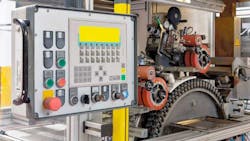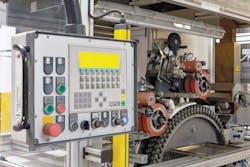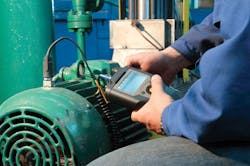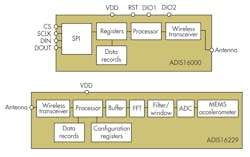Wireless Vibration Sensors Enable Continuous And Reliable Process Monitoring
Using factory automation to improve overall efficiency is a primary focus in today’s manufacturing industry. Organizations are shifting in this direction not only because it increases their bottom line, but also because it helps reduce or eliminate the severe costs of equipment downtime. Rather than relying on advanced methods to apply statistical data to predict maintenance needs, or simply having better-trained technicians, process control and predictive maintenance program developers can use wireless vibration sensors to enable accurate real-time analysis and controls.
Related Articles
- Energy Harvesting Powers Wireless Sensor Networks In Industrial Apps
- Energy Harvesting And Wireless Sensor Networks Drive Industrial Applications
- Power Your Wireless Sensors For 40 Years
Precision industrial processes increasingly are relying on efficient and consistent operation of motors and associated machinery (Fig. 1). Imbalance, defects, loose fittings, and other anomalies in the machinery typically translate into vibration and loss of precision, as well as safety concerns and inefficient performance. When these are left unaddressed, productivity losses become inevitable if equipment needs to be taken off the assembly line for repair. Even slight shifts in equipment performance, usually difficult to predict in a timely manner, quickly translate into measurable lost productivity.
Process monitoring and condition-based predictive maintenance help, and there are proven approaches for avoiding productivity loss. However, the value of these approaches is matched by their complexity. Existing methods have limitations, particularly when it comes to analyzing the vibration data—no matter how it’s collected—and isolating error sources.
Typical data collection approaches include handheld data collection tools and simple piezo-based sensors mounted to the machinery. These methods have a number of limitations, particularly when compared with the ideal solution of a complete detection and analysis system that can be embedded in the machinery and act autonomously. Before implementing a fully, embedded, and autonomous sensing system, it is important to understand and consider 10 factors that affect the data collection process, ranging from highly repeatable measurements to proper documentation and traceability.
This file type includes high resolution graphics and schematics when applicable.
Accurate And Repeatable Measurement
Existing handheld vibration probes offer some implementation advantages (Fig. 2). They do not require any modification to the end equipment. They’re also relatively highly integrated, given their large (brick) size, enabling sufficient processing and storage. One major drawback is the lack of repeatable measurements, though.
Slight differences in the probe location or angle will produce inconsistent vibration profiles, making time comparisons inaccurate. Therefore, the maintenance technician is left wondering whether any observed vibration shift is due to an actual change within the machinery or just a change in the measurement technique. Ideally, the sensor would be both compact and integrated sufficiently to allow direct and permanent embedding within the equipment, eliminating any concerns of measurement location shift and allowing complete flexibility in the scheduling of measurements.
Frequency And Scheduling of Measurements
Process monitoring can be particularly valuable in a production facility for high-value equipment, as in the manufacture of sensitive electronic components. In this instance, subtle shifts in the assembly line may lead to reductions in factory output, as well as critical end-equipment specification shifts. An obvious limitation of the handheld probe approach is the lack of real-time notification for inaccurate vibration shifts.
The same is true for most piezo-based sensors, which typically have a very low level of integration (transducer only in some cases), with the data transferred elsewhere for later analysis. These devices require external intervention, presenting a chance of missed events and shifts. In contrast, an autonomous sensor processing system that includes sensor, analysis, storage, and alarm capability all in a small form factor delivers the fastest notification of vibration shifts and best can show time-based trends.
Understanding The Data
Real-time notification from an embedded sensor is only possible if frequency domain analysis is employed. Any given equipment typically has multiple sources of vibration (bearing defects, imbalance, gear mesh), including those sources that are by design, such as a drill or machine press that produces vibration during standard operation. A time-based analysis of the equipment produces a complex waveform, combining these multiple sources and providing little discernible information prior to fast Fourier transform (FFT) analysis.
Most piezo-based sensor solutions rely on external computation and analysis of the FFT. This not only eliminates the possibility of real-time notification, it also places a substantial additional design burden on the equipment developer. With embedded FFT analysis on the sensor, vibration shifts can be isolated to specific sources immediately. Adding a fully integrated sensor also can reduce development time for equipment designers by six to12 months, depending on the completeness and simplicity of the fully integrated and autonomous sensor.
Data Access And Transmission
While embedded sensing is an ideal way to achieve accurate and real-time trend data, it complicates the task of transferring data to a remote process controller or operator. Embedded FFT analysis assumes that the analog sensor data has been conditioned and converted to digital to support simplified data transmission. In fact, most vibration sensor solutions in use today are analog output only, leading to signal degradation during transmission and complex offline data analysis.
Given that most industrial equipment requiring vibration monitoring tends to exist in noisy, moving, inaccessible, and even dangerous environments, there is a strong desire to reduce the complexity of interface cabling and to perform as much of the data analysis at the source as possible to capture the most accurate representation of the equipment vibration. A wirelessly enabled sensor node facilitates immediate access and greatly simplifies the deployment of the sensor network at a significantly reduced cost.
Data Directionality
Many existing sensor solutions are single-axis piezo transducers. These piezo sensors provide no directionality information, so they present a limited understanding of the equipment vibration profile. The lack of directionality translates into the need for very low-noise sensors to enable the necessary discernment. The availability of multi-axis MEMS-based (microelectromechanical systems) sensors allows a significant increase in the ability to isolate the vibration source, while also potentially improving cost.
Location And Distribution Of Sensors
Equipment vibration profiles are complex, time-shifting, and susceptible to variances based on the equipment materials and location. The question of where to place sensors is critical, but also highly dependent on the type of equipment, the environment, and even the life cycle of the equipment. With the high cost of sensor elements limiting the number of probe points to one or a few, this question is more critical.
This means either significant additional upfront development time to determine optimal placement through experimentation is required, or, in most cases, it compromises the quality and amount of data to be captured. The existence of more fully integrated sensor probes at a fraction of current costs can allow placement of multiple probes per system and less upfront development time and cost.
Adaption To Life-Cycle Shifts
While a handheld monitoring system approach can perhaps be tailored to changes (periodicity, amount of data, etc.) over time, providing that same life-cycle based customization in an embedded sensor requires upfront attention during design and deployment to allow the needed tunability. The transducer component, regardless of technology, is important. But sensor conditioning and processing wrapped around the transducer is typically more critical. The signal and sensor conditioning and processing is specific to unique equipment and its life cycle. This translates to several important considerations in sensor design.
Earlier analog-to-digital conversion (i.e., at the sensor head versus off-equipment) allows for configuration and tuning in-system. The ideal sensor would provide a simple programmable interface that would streamline equipment setup through quick baseline data captures manipulation of filtering, programming of alarms, and experimentation with different sensor locations. With existing simple sensors, some sensor settings must be compromised to accommodate changes in maintenance concerns over the life of the equipment.
For instance, designers need to determine if the sensor should be configured for early life, when equipment faults are less likely, or end-of-life, when faults are not only likely but potentially more detrimental. The preferred approach is an in-system programmable sensor that configures to changes during the life cycle. For example, relatively infrequent monitoring (for lowest power consumption) should be used during the early life cycle, followed by reconfiguration to frequent (user programmed period) monitoring once a shift (warning threshold) has been observed.
Identification Of Performance Shifts/Trends
Adapting the sensor to changes in equipment life cycle somewhat depends on knowledge of a baseline equipment response. Even simple analog sensors can allow this, assuming the operator takes measurements, performs the offline analysis, stores this data offline, and somehow properly tags to the specific equipment and probe location.
A preferred and less error-prone approach would allow baseline FFT storage at the sensor head, eliminating any potential for misplaced data. The baseline data also helps with establishing alarm levels, which again would ideally be programmed directly at the sensor. Therefore, in any subsequent data analysis and capture where warning or fault conditions are detected, a real-time interrupt can be generated.
Data Traceability And Documentation
Within a factory, a proper vibration analysis program may be monitoring tens or even hundreds of locations, whether by handheld probe or embedded sensor. Over the course of a given piece of equipment’s lifetime, this may produce the need to capture thousands of records. The integrity of the predictive maintenance program depends on the proper mapping to location and time of the sensor collection point. For the lowest risk, and the most valuable data, the sensor should have a unique serial number and the ability to time stamp the data, in addition to embedded storage.
Reliability
This discussion highlights methods to improve existing sensor-based approaches for vibration monitoring related to process control and predictive maintenance. In that spirit of fault tolerance and monitoring, the sensor itself should be scrutinized. What if the sensor becomes faulty (performance shift) rather than the equipment? Or, when operating with a fully autonomous sensor, how confident can we be that the sensor continues to work at all? With many transducers, such as piezo-based, this presents a serious limitation, as they have no means of providing any sort of in-system self-test.
There is always a lack of confidence in the consistency of data recorded over time. In the end-of-life critical monitoring phase where real-time fault notification is time and cost critical (not to mention a significant safety concern), there is always a concern that the sensor could become non-functional. An essential requirement of a high-confidence process control program is the ability to remotely self-test the transducer. Fortunately, this is possible with some MEMS-based sensors. An embedded digital self-test closes the final gap on a reliable vibration monitoring system.
In The Field
The ADIS16229 digital MEMS vibration sensor with embedded RF transceiver from Analog Devices is an example of a fully autonomous and wireless frequency domain vibration monitor capable of all of the advantages outlined here. It features embedded frequency domain processing, a 512-point real-value FFT, and on-board storage, providing the ability to identify and classify individual sources of vibration, monitor their changes over time, and react to programmable threshold levels.
The device also provides configurable spectral alarm bands and windowing options allowing analysis of the full frequency spectrum via the configuration of six bands and two alarms (warning threshold and fault threshold) for earlier and more accurate detection of problems. At its core is a multi-axis, wide-bandwidth MEMS-based sensor with configurable sample rate (up to 20 ksamples/s) and averaging/decimation options enabling more accurate assessment of even subtle vibration profile changes.
The MEMS sensor provides a digital self-test mode to provide continuous confidence in functionality and data integrity. The device is fully embedded and programmable, enabling placement close to the vibration source and early detection of small signals in a repeatable way, avoiding data discrepancies due to differences in location/coupling from measurement-to-measurement, which can be the case when using handheld devices.
A proprietary 902.5/927.5-MHz wireless protocol interface allows the ADIS16229 sensor node to be remotely located. The ADIS16000 gateway node provides a standard serial peripheral interface (SPI) to any system controller device, supporting the ADIS16229 (Fig. 3). Up to six remote sensor nodes can be controlled via the gateway (Fig. 4).
Fully integrated and reliable vibration sensors, capable of autonomous and configurable operation, provide process control and enable predictive maintenance programs to significantly improve the quality and integrity of the data collection process, without the limitations and compromises posed by past vibration analysis approaches.
With the high level of integration and a simplified programmable and wireless interface, these sensors also can enable a more pervasive deployment of vibration sensing. Such fully integrated sensors, which do not depend on retrofitted wiring/infrastructure and more precisely and reliably detect performance shifts, offer the opportunity to drastically reduce upfront and recurring maintenance costs.
About the Author
Bob Scannell
Business Development Manager
Bob Scannell is a business development manager for Analog Devices’ Inertial MEMs Products. He has been with ADI for 18 years in various technical marketing and business development functions ranging from sensors to DSP to wireless. Previously, he worked at Rockwell International in both design and marketing. He holds a BS degree in electrical engineering from the University of California, Los Angeles, and an MS in computer engineering from the University of Southern California.






